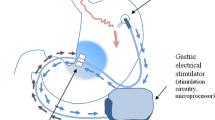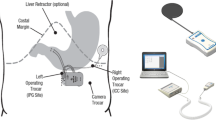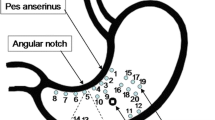Abstract
Background
Mechanical stimulation of the stretch receptors of the gastric wall can simulate the presence of indigested food leading to reduced food intake. We report the preliminary experimental results of an innovative concept of localized mechanical gastric stimulation.
Methods
In a first survival study, a biocompatible bulking agent was injected either in the greater curvature (n = 8) or in the cardia wall (n = 8) of Wistar rats. Six animals served as sham. Changes of bulking volume, leptin levels and weight gain were monitored for 3 months. In a second acute study, a micro-motor (n = 10; MM) or a size-paired inactive device (n = 10; ID) where applied on the cardia, while 10 additional rats served as sham. Serum ghrelin and leptin were measured at baseline and every hour (T0–T1–T2–T3), during 3 h. In a third study, 24 implants of various shapes and sizes were introduced into the gastric subserosa of 6 Yucatan pigs. Monthly CT scans and gastroscopies were done for 6 months.
Results
Weight gain in the CW group was significant lower after 2 weeks and 3 months when compared to the shame and GC (p = 0.01/p = 0.01 and p = 0.048/p = 0.038 respectively). Significant lower increase of leptin production occurred at 2 weeks (p = 0.01) and 3 months (p = 0.008) in CW vs. SG. In the MM group significant reduction of the serum ghrelin was seen after 3 h. Leptin was significantly increased in both MM and ID groups after 3 h, while it was significantly reduced in sham rats. The global device retention was 43.5%. Devices with lower profile and with a biocompatible coating remained more likely in place without complications.
Conclusions
Gastric mechanical stimulation induced a reduced weight gain and hormonal changes. Low profile and coated devices inserted within the gastric wall are more likely to be integrated.





Similar content being viewed by others
References
Must A, Spadano J, Coakley EH, Field AE, Colditz G, Dietz WH (1999) The disease burden associated with overweight and obesity. JAMA 282:1523–1529
Pop R, Kong SH, Langlois A, Marchegiani F, Shlomovitz E, Legner A, Bietiger W, Pinget M, Beaujeux R, Mutter D, Marescaux J, Diana M (2019) Gastrointestinal hormones manipulation to counteract metabolic syndrome using duodenal targeted embolization. Surg Innov 26:280–292
Abdeen G, le Roux CW (2015) Mechanism underlying the weight loss and complications of Roux-en-Y gastric bypass. Review. Obes Surg. https://doi.org/10.1007/s11695-015-1945-7
Rashti F, Gupta E, Ebrahimi S, Shope TR, Koch TR, Gostout CJ (2014) Development of minimally invasive techniques for management of medically-complicated obesity. World J Gastroenterol 20:13424–13445
Weiss R (2008) Devices for the treatment of obesity: will understanding the physiology of satiety unravel new targets for intervention? J Diab Sci Technol 2:501–508
Lu X, Guo X, Mattar SG, Navia JA, Kassab GS (2010) Distension-induced gastric contraction is attenuated in an experimental model of gastric restraint. Obes Surg 20:1544–1551
Cha R, Marescaux J, Diana M (2014) Updates on gastric electrical stimulation to treat obesity: systematic review and future perspectives. World J Gastrointest Endosc 6:419–431
Hasler WL (2009) Methods of gastric electrical stimulation and pacing: a review of their benefits and mechanisms of action in gastroparesis and obesity. Neurogastroenterol Motil 21:229–243
Kilkenny C, Browne WJ, Cuthill IC, Emerson M, Altman DG (2010) Improving bioscience research reporting: the ARRIVE guidelines for reporting animal research. PLoS Biol 8:e1000412
Diana M, Halvax P, Mertz D, Legner A, Brule JM, Robinet E, Mutter D, Pessaux P, Marescaux J (2015) Improving echo-guided procedures using an ultrasound-CT image fusion system. Surg Innov 22:217–222
Arepally A, Barnett BP, Patel TH, Howland V, Boston RC, Kraitchman DL, Malayeri AA (2008) Catheter-directed gastric artery chemical embolization suppresses systemic ghrelin levels in porcine model. Radiology 249:127–133
Fernandes M, Atallah AN, Soares BG, Humberto S, Guimaraes S, Matos D, Monteiro L, Richter B (2007) Intragastric balloon for obesity. Cochrane Database Syst Rev. https://doi.org/10.1002/14651858.CD004931.pub2
Foschi D, Corsi F, Lazzaroni M, Sangaletti O, Riva P, La Tartara G, Bevilacqua M, Osio M, Alciati A, Bianchi Porro G, Trabucchi E (2007) Treatment of morbid obesity by intraparietogastric administration of botulinum toxin: a randomized, double-blind, controlled study. Int J Obes 31:707–712
Weiss CR, Kathait AS (2017) Bariatric embolization: a new and effective option for the obese patient? Expert Rev Gastroenterol Hepatol 11:293–302
Bawudun D, Xing Y, Liu WY, Huang YJ, Ren WX, Ma M, Xu XD, Teng GJ (2012) Ghrelin suppression and fat loss after left gastric artery embolization in canine model. Cardiovasc Intervent Radiol 35:1460–1466
Diana M, Pop R, Beaujeux R, Dallemagne B, Halvax P, Schlagowski I, Liu YY, Diemunsch P, Geny B, Lindner V, Marescaux J (2015) Embolization of arterial gastric supply in obesity (EMBARGO): an endovascular approach in the management of morbid obesity. proof of the concept in the porcine model. Obes Surg 25:550–558
Diana M, Halvax P, Pop R, Schlagowski I, Bour G, Liu YY, Legner A, Diemunsch P, Geny B, Dallemagne B, Beaujeux R, Demartines N, Marescaux J (2015) Gastric supply manipulation to modulate ghrelin production and enhance vascularization to the cardia: proof of the concept in a porcine model. Surg Innov 22:5–14
Kipshidze N, Archvadze A, Bertog S, Leon MB, Sievert H (2015) Endovascular bariatrics: first in humans study of gastric artery embolization for weight loss. JACC Cardiovasc Interv 8:1641–1644
Weiss CR, Akinwande O, Paudel K, Cheskin LJ, Holly B, Hong K, Fischman AM, Patel RS, Shin EJ, Steele KE, Moran TH, Kaiser K, Park A, Shade DM, Kraitchman DL, Arepally A (2017) Clinical safety of bariatric arterial embolization: preliminary results of the BEAT obesity trial. Radiology 283:598–608
Chen J (2004) Mechanisms of action of the implantable gastric stimulator for obesity. Obes Surg 14(Suppl 1):S28–32
Horbach T, Thalheimer A, Seyfried F, Eschenbacher F, Schuhmann P, Meyer G (2015) abiliti closed-loop gastric electrical stimulation system for treatment of obesity: clinical results with a 27-month follow-up. Obes Surg 25:1779–1787
Anton K, Rahman T, Bhanushali A, Patel AA (2016) Bariatric left gastric artery embolization for the treatment of obesity: a review of gut hormone involvement in energy homeostasis. AJR Am J Roentgenol 206:202–210
Cigaina V, Hirschberg AL (2003) Gastric pacing for morbid obesity: plasma levels of gastrointestinal peptides and leptin. Obes Res 11:1456–1462
van Helden DF, Laver DR, Holdsworth J, Imtiaz MS (2010) Generation and propagation of gastric slow waves. Clin Exp Pharmacol Physiol 37:516–524
Sallam HS, Oliveira HM, Liu S, Chen JD (2010) Mechanisms of burn-induced impairment in gastric slow waves and emptying in rats. Am J Physiol Regul Integr Comp Physiol 299:R298–305
Acknowledgements
Authors are grateful to Iana Shutrova, Guy Temporal and Christopher Burel, professional in Medical English proofreading, for their valuable help with the manuscript revision.
Funding
This study was funded by an IHU-Strasbourg feasibility grant and by the 2016 EAES Research Grant (recipient Michele Diana).
Author information
Authors and Affiliations
Corresponding author
Ethics declarations
Disclosure
Michele Diana, Peter Halvax and Lee Swanström are the inventors of the GAMMA concept. Jacques Marescaux is the President of both IRCAD and IHU-Strasbourg institutes, which are partly funded by Karl Storz, Siemens and Medtronic. None of the industrial partners participate in any aspect of this study. Andras Legner, Seong-Ho Kong, Yu-Yin Liu, Galyna Shabat, Alend Saadi and Marc Worreth have no conflicts of interest or financial ties to disclose.
Additional information
Publisher's Note
Springer Nature remains neutral with regard to jurisdictional claims in published maps and institutional affiliations.
Rights and permissions
About this article
Cite this article
Legner, A., Kong, SH., Liu, YY. et al. The GAMMA concept (gastrointestinal activity manipulation to modulate appetite) preliminary proofs of the concept of local vibrational gastric mechanical stimulation. Surg Endosc 34, 5346–5353 (2020). https://doi.org/10.1007/s00464-019-07325-5
Received:
Accepted:
Published:
Issue Date:
DOI: https://doi.org/10.1007/s00464-019-07325-5




